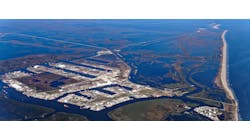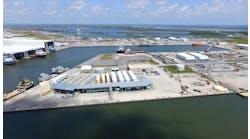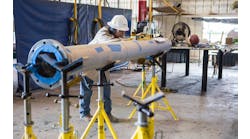Focus on efficiencies delivers time and cost savings
Judy Murray, Contributing Editor
Edison Chouest Offshore (ECO) has come a long way since Edison Chouest Boat Rentals was established 60 years ago in Galliano, with the launch of the Holiday utility vessel. Today, six decades after its inception, ECO has expanded far beyond boat rentals, establishing itself as one of the most diverse and dynamic marine transportation solution providers in the world.
The company’s current leadership position is due in part to its ability to design and build technologically advanced, high-capacity vessels that it also owns and operates. Being able to manage the fleet from conception through operations allows ECO to identify areas for improvement and determine where a new design or capability could introduce competitive advantages. The result is a diverse fleet that delivers value and efficiencies around the world.
The ECO fleet numbers more than 200 vessels ranging in length from 87 ft (26.5 m) to more than 525 ft (160 m). The operating fleet includes light construction vessels, anchor handlers, platform supply vessels, multi-purpose supply and fast supply vessels, oil spill response vessels, tractor tugs, and a range of specialty vessels. ECO has multiple shipbuilding and repair yards in Louisiana, Mississippi, Florida, and Brazil.
Setting up capabilities
Having in-depth knowledge of vessels and the experience of many years working in the Gulf of Mexico (GoM) provided the insight needed for ECO to develop a multi-service complex in Port Fourchon.
Management at ECO recognized the challenge of servicing assets in the GoM as an opportunity to develop a solution. The first step was in 1997 with the creation of what is known as C-Port, a facility that enables ECO to offer cutting-edge vessel support technology and marine material movement. Over the next few years, ECO added C-Port 2 and C-Port 3 to expand its presence in Port Fourchon.
The C-Port complex includes three terminals that serve as the focal point of the company’s Port operations. These terminals include 24 covered slips configured to optimize cargo transfer along with more than 25,000 sq ft (2,322 sq m) of covered staging area and 33,000 sq ft (3,066 sq m) of outdoor storage. There are facilities for pipe storage, testing and repair, and bucking services for pipe up to 12 in. in diameter. Certified professionals are on hand to load and offload risers or perform riser inspections and repairs. C-Port has 25-ft (7.6-m) drafts to accommodate large offshore vessels and 47 overhead cranes ready for complete dockside services 24 hours a day. The facility can manage as many as eighty-eight 300-ft (91.4-m) vessels at a time with a throughput of 450-500 vessels a day.
According to Reggie Ledet, general manager of ECO’s C-Port 3, having multiple facilities in one location with a range of functions delivers significant value for customers. “Chouest offers a package of services that makes it easy for companies to efficiently get into and out of the Port with everything they need,” he says. “Our facilities are very well thought out and planned for effectiveness.”
The covered slips in the Chouest port facilities deliver unique benefits and efficiencies, according to C-Logistics General Manager Dane Vizier, Sr.
“Bad weather doesn’t shut them down,” he says, explaining that safety measures dictate shutdowns for outdoor operations in inclement conditions. “All workers move indoors when there is lightning within 10 mi of the Port, and shutdowns are required for conditional cranes working outdoors when winds reach 35 mph.”
In the covered slips where the cranes are protected, however, there is no need to stop because operations are not affected by weather, Vizier says. Even when there is a power outage, there are backup generators to keep crews working 24/7, 365 days a year.
The cranes used in the Chouest port facilities are electric — meaning there are no emissions — and because they are positioned for optimal efficiency, they simplify the loading and unloading process. “The cranes can easily load the deck from stem to stern, and they are much easier to operate because the operator is in a basket with a bird’s eye view of the deck, where he has a clear line of sight,” Vizier explains. “This makes operations much safer. It also makes us a lot more efficient than everyone else.”
The arrangement of the slips delivers additional advantages. Because the slips are designed so intakes are at back of slip, a vessel can take on mud and bulk products while a crane is loading the vessel. “This is the only place in the world that you can load a vessel at the same time that it is taking on mud,” he says.
“Time is money,” says Ledet. “It’s our job to get the vessel in here and back offshore in a safe and timely manner.”
Expanded services
ECO has a range of businesses in Port Fourchon in addition to the three C-Port facilities. The company’s offshore support services has 2,486 ft (758 m) of bulkhead with dockside mobile crane services as well as warehousing with gantry crane support. It offers full-service fuel and lube services and houses five diesel fuel transfer stations as well as storage for 400,000 gallons of freshwater and six associated transfer stations.
Two yards make up the company’s Martin Terminal. The smaller North Yard has 1,914 linear feet of bulkhead with dockside mobile cranes and forklift services, warehousing, and outdoor storage for 210,000 gallons of fresh water and six transfer stations. The South Yard has 2,130 linear feet of bulkhead and houses 3,200,000 gallons of diesel fuel with seven transfer stations and 1,680,000 gallons of freshwater with 14 transfer stations. The Martin South Yard also has storage and transfer stations for methanol, xylene, and glycol.
ECO established Clean Tank in 1998 to provide tank cleaning and fluid recovery services to oil and gas companies operating out of Port Fourchon. Clean Tank has since evolved into one of the largest tank cleaning companies serving the US Gulf Coast with services that include cleaning of liquid mud, dry bulk, fuel, methanol and chemical tanks; fuel and chemical recovery and filtering; and cleaning of bilges, frac tanks, MPTs, cutting boxes, valves, baskets and other miscellaneous oil and gas containment devices and equipment.
The C-Logistics facility, opened in 1999, offers material movement and containerization, fleet management and reporting as well as file and document storage. ECO’s C-Logistics team captures such useful information as engine vibration, fuel efficiency, and fuel consumption data in real time. Approximately 4,000 data points are being monitored on each vessel, allowing the company to determine when service and maintenance should be done and where design or equipment performance could be enhanced.
The Northern Expansion also is part of the ECO offering in the Port. It features two wet slips, each equipped with two 25-ton gantry cranes and a 15-story covered drydock with two 50-ton gantry cranes. This facility has 3,500 ft of linear bulkhead with a dockside mobile crane and forklift service as well as shoreside electrical services.
Fourchon Heavy Lift, added in 2006, is home to a 475-ton derrick crane and offers outdoor storage on a site with 1,320 linear ft of bulkhead. This facility provides dockside mobile crane and forklift services in addition to heavy-lift capabilities, subsea construction support, long-term heavy-lift storage, and warehousing.
ECO’s C-Terminal, which opened in 2013, has three dockside pedestal cranes in addition to dockside mobile crane and forklift services and warehousing. The facility houses a bulk/cement/barite plant and provides fuel, water, mud and drilling fluids for purchase on site.
The company’s expansive presence in Port Fourchon allows ECO to offer services for all types of exploration and development work in the GoM.
“We have a huge range of resources for companies working in the Gulf of Mexico,” Ledet says. “We offer so many more services here that it makes perfect business sense for customers to come to us.” •




